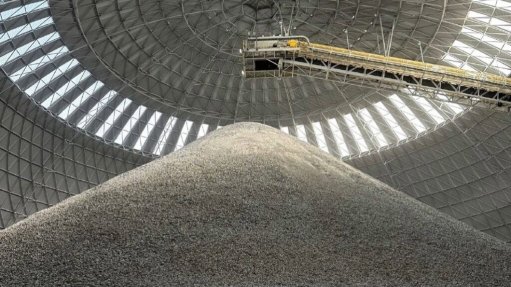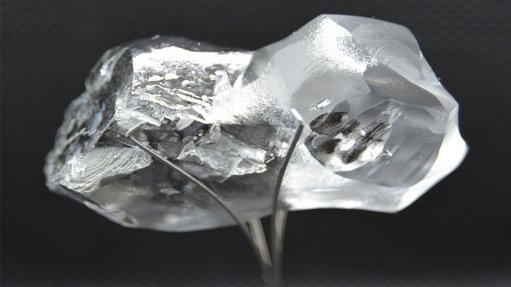The Company wishes to respond to recent comments and actions by the Confederation of Namibian Fishing Associations (“CNFA”)
This article has been supplied as a media statement and is not written by Creamer Media. It may be available only for a limited time on this website.
The Honourable Minister of Fisheries and Marine Resources (“MFMR”) and certain other commentators which have been published recently in the Namibian press in relation to the award of the Environmental Clearance Certificate to Namibian Marine Phosphate (Pty) Limited (“NMP”) for the Sandpiper Marine Phosphate Project (“the Project”) in relation to the granted mining license ML170 by the office of the Environmental Commissioner (“the EC”) in October 2016.
The portrayal by these parties of the decision by the Ministry of Environment and Tourism (“MET”) and the EC as “reckless” and the allegation that this decision will result in “scandalous damage to ecosystem” are wholly unsupported by scientific data and intentionally sensationalistic and emotive by design to mislead public opinion. When making these claims these parties also purposefully choose to ignore the scale of the proposed phosphate dredging operations and purposefully deflect any discussion on the relevance of the related comparative impacts fishing (bottom trawling) industry or marine diamond mining.
Not one shred of credible scientific evidence has been put provided by any of these parties to support their positions. One has to wonder why that is so?
There are several crucial considerations that MFMR, CNFA and other prominent commentators have either deliberately or inadvertently chosen to ignore and leave out of the public conversation in regard because they completely undermine their statements and the basis for positions they have taken on the matter Scale of Operations.
The fact is that the scale of the proposed phosphate dredging operations will be significantly less than that of the existing fishing/trawling and marine diamond mining activities:
- Proposed Phosphate dredging will affect an area of 2.5 - 3 Km2 per year at a fixed location within ML170 By Comparison:
- Current Marine diamond mining/dredging operations affects an area off approx. 10-14 Km2 per year
- Current Fishing operations - A single bottom trawler can affect up to 10 Km2 of seabed per DAY.
Registration No. 2008/0916
- There are more than 100 registered demersal/bottom trawlers in Namibia that fish all year round over the length and the Namibian EEZ/continental shelf area (approx. 580,000km2)
Ecosystem Impact
CNFA and Chairperson Matti Amukwa are on public record justifying their claim, supported by MFMR, that proposed phosphate dredging will cause significant impact to the marine environment and the fishing industry on the basis that “the mining sediment plume could drift over the fish breeding grounds and have a suffocating impact”.
This position is both confusing and misleading when considering that CNFA have publically acknowledged the internationally proven and accepted fact that “the fishing industry (in Namibia) does disturb the seabed when trawling” Both CFNA and MRMR have been fully aware of this fact for many years yet neither of these managing authorities have produced a formal Strategic Environmental Assessment for fishing management nor have they produced a study on the cumulative effects of seabed disturbance from trawling in the Benguela Current ecosystem off the coast of Namibia.
A scientific study in Norway on the re-suspended sediment load contained in plumes generated by trawling, concluded:
- That “5 tonnes of sediment was put into suspension over a 2 km trawl track with a trawl width of of 25m.”
- This equates to 2.5 tons of suspended sediment per 1 km of trawl track.
- Release of toxins contained in the sediment pore waters was also recorded as a consequence of trawl generated sediment plumes.
- Based on the data from the Norwegian study then, a single trawl track 25m wide and 25 km long would have generated 62.5 tons of suspended sediment load.
The Study concludes that taking in consideration the estimated amount of sediment suspended worldwide due to trawling (1750 million m3 yr-1 ) compared to the amounts spilled from dredging operations (12.5 – 27.5 million m3 ) the impacts should be of concern in the management of bottom trawling Registration No. 2008/0916
Figure 1 Plume from 1 Diamond Mining Vessel
Figure 2 Plume from 1 Dredger Registration No. 2008/0916
Figure 3 Plumes from multiple bottom trawlers
Figure 4 Plume from 1 bottom trawler Registration No. 2008/0916
Based on the above, it is clear that the cumulative effects of the current active trawler fleet in Namibia are likely to be substantially larger than the current diamond mining operations or the phosphate dredging at the proposed scale of operations in ML170.
Yet CNFA Chairperson is on record stating that “The South African hake trawling sector has been operating for 120 years without any significant adverse environmental effects”. MFMR and CNFA are satisfied that the environment and fish stocks off Namibia are not being affected by the significant sediment plumes and disturbance from trawling across the continental shelf off Namibia.
It that is the case then what scientifically supported justification do they have to suggest that the addition of the phosphate dredging a the proposed scale of operations will pose any substantive additional or greater risk to the fishing industry or cause the proclaimed “ sudden and catastrophic destruction” of the marine environment and fish stocks off Namibia??
Frankly the argument put forward by CNFA and MFMR “does not hold water” and is contradicted by their own industry claims and operations. Furthermore The SP1 area lies entirely outside the commercial hake and monkfish grounds. The Project EIA has assessed a zero percent (0%) operational impact on the commercial hake and monkfish grounds within the SP1 area Due Process.
NMP has followed due process and the Environmental Impact Assessment (“EIA”), Environmental Management Plan (“EMP”), Verification Study (“Study”) and the two independent studies independently commissioned by the EC have confirmed that phosphate mining will have minimal impact on the marine environment.
Let’s look at the facts:
- The issue of MLA 170 was subject to an inter-ministerial review, including MFMR
- The EIA and supporting studies were prepared in accordance with the Environmental Management Act of 2007
- The EIA and supporting studies concluded that there will be “minimal impact” to the marine environment
- Both the MFMR and CNFA have been party to and actively involved in the deliberations and conclusions as drawn by the EC
- MFMR chaired a workshop meeting jointly with MET and the EC at MFMR offices in Swakopmund to which NMP was invited in April 2016 to address MFMR’s final set of outstanding queries from the Verification Study in order for MFMR and the EC to present
Registration No. 2008/0916
- Their recommendations to the Cabinet Committee on Trade and Industrial Development. At closure of this meeting the EC advised that “he has received all the necessary information to form a conclusion in relation to the finalisation of the NMP EIA”
- At the recommendation of the External Reviewer appointed by the EC and in accordance with the preferences expressed by MFMR at consultation meetings in 2012, NMP engaged at their own expense the best available Scientific professionals to complete the Verification Study and to review through an “Independent Peer Review Process” the findings on the EIA, EMR and Study to ensure the best available factual scientific evidence was provided in support of the application for an environmental clearance for ML170
During a period of over 5 years, MFMR and CNFA have continuously resisted any fair and reasonable consideration of the scientifically substantiated facts and internationally accredited expert opinions that wholeheartedly support the conclusion “a minimal environmental impact of the proposed dredging activities in ML170 and a respectful functional co-existence alongside the existing commercial fishing industry”.
Despite the due process followed by NMP, EC and MET, the CNFA and MFMR have continued to distort facts and promote a sensationalised stance that the proposed dredging of phosphatic sediments will cause substantive impacts on the marine environment and the commercial fishing industry, without providing any scientifically substantiated facts..
In so doing they have chosen to:
- Discredit the integrity and thorough due process administrated by the office of the EC and MET for evaluation and award of environmental clearance certificates in terms of the Environmental Management Act 2007
- Engage legal and political actions that can result in a gratuitous waste of public funds and commercial resources
- Take an obstructive and aggressive position on the issue of attracting and valuing foreign investment in Namibia to further the industrial growth and socioeconomic development of the nation
- Create an emotional reaction with no factual evidence of why phosphate mining and fishing cannot co-exist
In response to the invitation by the Government of Namibia (GRN) to attract foreign investors, since 2008 NMP shareholders have invested more than N$780 million into the development of the exploration and mining licenses issued by GRN to NMP and now included in the Sandpiper project. The funds have gone towards exploration, environmental, technical and feasibility studies, Registration No. 2008/0916
administration and local employment. The project development amounts to N$5.2 billion investment capital, making it one of the single largest investment projects the country. It will have annual revenues of N$4.2 billion and contribute royalties of N$78m per annum to the national fiscus. In addition, corporate taxes of N$650m per annum will be paid.
Comments
Press Office
Announcements
What's On
Subscribe to improve your user experience...
Option 1 (equivalent of R125 a month):
Receive a weekly copy of Creamer Media's Engineering News & Mining Weekly magazine
(print copy for those in South Africa and e-magazine for those outside of South Africa)
Receive daily email newsletters
Access to full search results
Access archive of magazine back copies
Access to Projects in Progress
Access to ONE Research Report of your choice in PDF format
Option 2 (equivalent of R375 a month):
All benefits from Option 1
PLUS
Access to Creamer Media's Research Channel Africa for ALL Research Reports, in PDF format, on various industrial and mining sectors
including Electricity; Water; Energy Transition; Hydrogen; Roads, Rail and Ports; Coal; Gold; Platinum; Battery Metals; etc.
Already a subscriber?
Forgotten your password?
Receive weekly copy of Creamer Media's Engineering News & Mining Weekly magazine (print copy for those in South Africa and e-magazine for those outside of South Africa)
➕
Recieve daily email newsletters
➕
Access to full search results
➕
Access archive of magazine back copies
➕
Access to Projects in Progress
➕
Access to ONE Research Report of your choice in PDF format
RESEARCH CHANNEL AFRICA
R4500 (equivalent of R375 a month)
SUBSCRIBEAll benefits from Option 1
➕
Access to Creamer Media's Research Channel Africa for ALL Research Reports on various industrial and mining sectors, in PDF format, including on:
Electricity
➕
Water
➕
Energy Transition
➕
Hydrogen
➕
Roads, Rail and Ports
➕
Coal
➕
Gold
➕
Platinum
➕
Battery Metals
➕
etc.
Receive all benefits from Option 1 or Option 2 delivered to numerous people at your company
➕
Multiple User names and Passwords for simultaneous log-ins
➕
Intranet integration access to all in your organisation


















